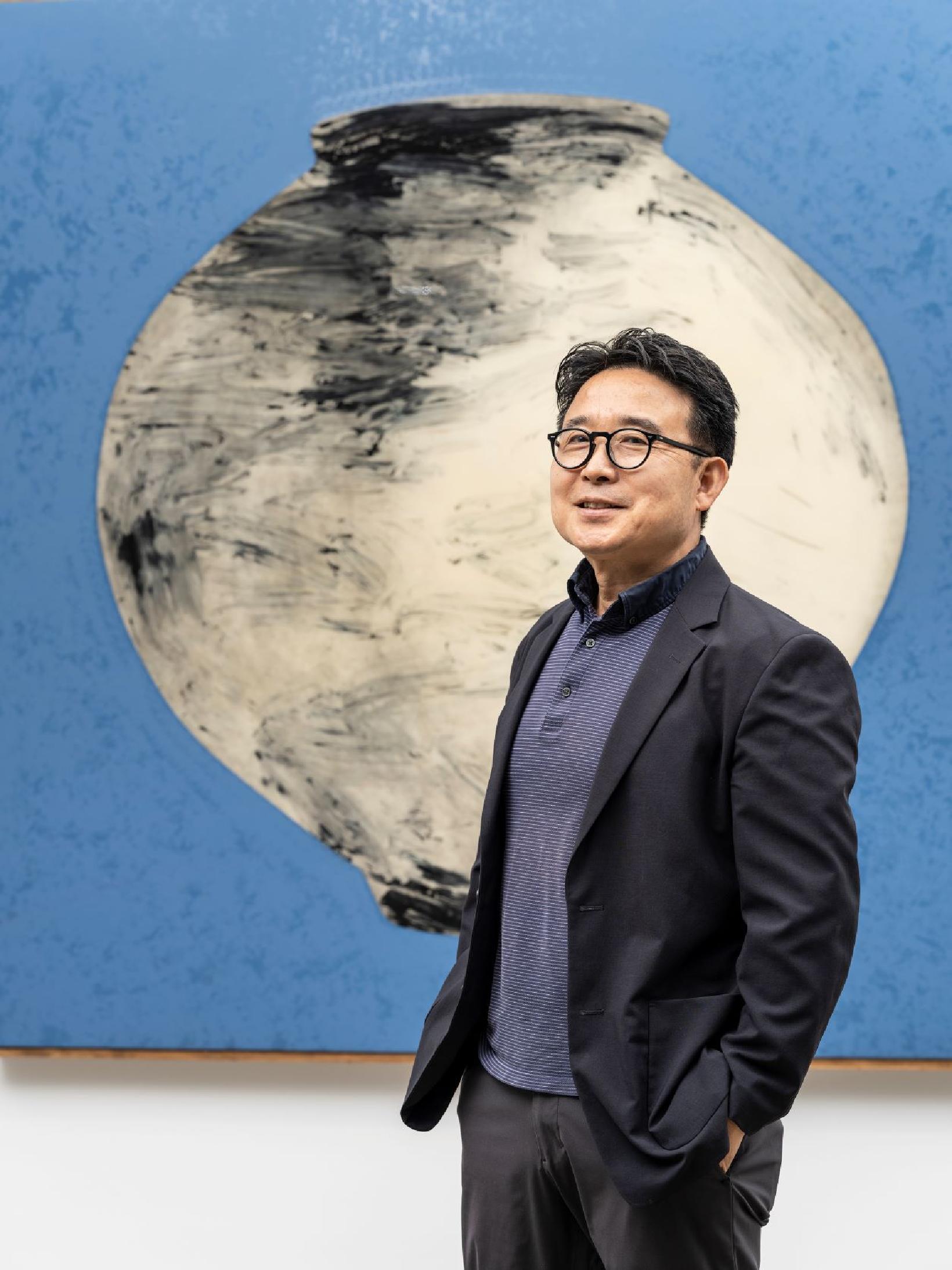Ik-Joong Kang was born in 1960 in Cheongju, North Chungcheong Province. After receiving a degree in Western painting from Hongik University in 1984, he left for New York, where he studied at the Pratt Institute. Since graduating from there in 1987, he has been based in New York.
When he first arrived to study overseas in 1984, he worked 12-hour per day, doing odd jobs and part-time work to pay for his education. Constantly pressed for time, he took to carrying small canvases around in his pocket, producing his work while commuting on the subway. This was the origin of the “three-inch” works for which he is best known today. Kang has used various letters, symbols, and images to express his daily life on the canvas. The panels have come to capture his own personal history, including his experiences in New York and the associated cultural disconnection, along with everyday motifs related to New York and his home in Korea. In this way, they juxtapose different times and places: Korea and the US, his childhood and the present, his “home” and a “foreign land,” yesterday and today. The blending and harmonizing of Eastern and Western landscapes, languages, and cultures would become a key concept in his oeuvre. The concept of “connecting” disparate or disconnected things has been pivotal to his artistic vision, and it has also been expanded in the many large-scale public projects that Kang has pursued in Korea and overseas.
Kang’s public art projects have been presented in Korea and other countries. His works of international public art include murals in the main hall of the San Francisco International Airport building, environmental sculptures in New York subway stations, ceiling installations at New York train station platforms, and a lobby mural Happy World at the Princeton Public Library. His domestic works include Moon over Gwanghwamun (2007-2010) displayed in front of the construction site of Gwanghwamun, 50,000 Windows, Wall of Hope (2010) made with works and hopes of 50,000 children, Things I Know (2010), covering the exterior of Korean pavilion at 2010 Shanghai Expo, Bridge of Dream (2013) at Suncheon Bay Garden, Going Home (2016) and Arirang (2016) at Odu Mountain Unification Observatory, Floating Dreams (2016) at the Thames Festival in London, Memorial Garden (2018) collaborated with 65,000 citizens of Suncheon and Gwanghwamun Arirang (2020) installed to commemorate the 70th anniversary of the Korean War to name a few.
Ik-Joong Kang had a two-person show Multiple / Dialogue (1994) with Nam June Paik at the Whitney Museum of American Art at Champion, and was awarded the Special Merit Award by representing the Korean Pavilion at Venice Biennale (1997). The artist has also presented many installation works in and out of Korea such as 100,000 Dreams (1999) at Paju Unification Park, Amazed World (2001) at United Nations, New York, Amazed World (Hope and Dream) (2005) at Muhammad Ali Center, Louisville, and Samramansang: Multiple / Dialogue ∞ (2009), which displayed around 60,000 pieces of 3-inch works.
Kang’s work has been included the collections on numerous major art institutions in Korea and abroad, including the Guggenheim Museum (New York); the British Museum (London); the Whitney Museum of American Art (New York); the Museum of Contemporary Art, Los Angeles; the Museum of Fine Arts Boston; the Museum Ludwig (Cologne); the National Museum of Modern and Contemporary Art, Korea (Seoul); the Seoul Museum of Art; the Gyeonggi Museum of Modern Art (Ansan), and the Leeum Museum of Art (Seoul). In addition to painting, Kang also expresses his everyday discoveries in writing, publishing poetry and art collections such as The Water in Your Heart Must Be Calm for You to See Me (2022), Sarubia (2019), and Moon Jar (2018). At the moment, he is involved in ongoing studies for a dream project of his: “Bridge of Dreams” on the Imjin River connecting North and South Korea.
강익중은 1960년 충청북도 청주에서 태어났다. 1984년 홍익대학교 미술대학 서양화과를 졸업한 그는 뉴욕으로 건너가 프랫인스티튜트에서 수학하고 1987년 졸업한 이후 뉴욕에서 작품활동을 이어오고 있다.
1984년 유학 첫해부터 하루 12시간의 잡역과 아르바이트를 해가며 학교를 다녔다. 늘 시간에 쫓기던 그는 작은 캔버스 여러 개를 주머니 속에 가지고 다니며 오가는 지하철 안에서 작업하였고, 이것이 지금 널리 알려진 작가의 ‘3인치’ 작품의 시작이었다. 작은 캔버스 안에 그의 일상이 각종 문자, 기호, 그림으로 담겼다. 이 작품들은 뉴욕 이주의 경험과 문화적 괴리감, 고향과 뉴욕의 일상적 모티브라는 강익중의 사적 역사가 담긴 패널로써 한국과 미국, 그의 유년 시절과 현재, 고향과 타향, 과거와 현재 등 시공간이 중첩된다. 동양과 서양의 풍경과 언어, 문화의 융합과 조화는 그의 작품을 이루는 핵심적인 개념이 되었다. 서로 다른 것 혹은 끊어진 것을 연결하는 개념은 그의 작품 세계에서 중추적인 역할을 하며, 국내외에서 진행해 온 수많은 대형 공공 프로젝트 작품으로 확장된다.
강익중은 1994년 휘트니미술관에서 백남준과《멀티플/다이얼로그》전을 열었고, 1997년 베니스 비엔날레에 한국관 대표로 참가하여 특별상을 수상하였다. 1999년 파주 통일공원에서의 <10만의 꿈> 설치와 2001년 뉴욕 UN본부에서 <놀라운 세상>, 2005년 루이빌 무하마드알리센터에 <놀라운 세상(희망과 꿈)>, 2009년 3인치 작품 6만여 점이 전시된 국립현대미술관의 <삼라만상 : 멀티플/다이얼로그 ∞> 등 수많은 설치 작업을 선보인 바 있다.
작가는 국내외에서 공공미술 프로젝트를 소개하고 있다. 해외의 공공미술 작품으로 샌프란시스코 국제공항청사 메인홀의 벽화와 뉴욕 지하철역의 환경조형물, 뉴욕 기차역 플랫폼의 천장 설치 작품, 프린스턴공립도서관의 로비 벽화 <행복한 세상> 등이 있고, 국내에는 광화문 복원 현장의 <광화문에 뜬 달>(2007-2010), 전국 5만 어린이들의 꿈을 모아 만든 경기도미술관의 <5만의 창, 미래의 벽>(2010), 2010년 상하이 엑스포 한국관의 외관을 42,000점의 한글 작품으로 덮은 <내가 아는 것>(2010), 순천만국가정원의 <꿈의 다리>(2013), 오두산 통일전망대 <그리운 내 고향>(2016)과 <아리랑>(2016), 런던 템즈강 페스티벌의 메인 작품인 <집으로 가는 길>(2016), 순천 시민 6만 5천여 명과 함께 만든 <현충정원>(2018) 그리고 6.25전쟁 70주년 기념으로 서울 광화문 광장에 설치된 <광화문 아리랑>(2020) 등이 있다.
그의 작업은 뉴욕 구겐하임미술관, 런던 대영박물관, 뉴욕 휘트니미술관, 로스앤젤레스현대미술관, 보스턴미술관, 루드비히미술관, 국립현대미술관, 서울시립미술관, 경기도미술관, 리움미술관 등 국내외 주요 미술 기관에 소장되어 있다. 일상에서의 발견을 그림뿐만 아니라 글로 표현하는 강익중은『마음에 담긴 물이 잔잔해야 내가 보인다』(2022),『사루비아』(2019),『달항아리』(2018)와 같은 시화집도 꾸준히 출간하고 있다. 또한, 강익중은 남과 북을 잇는 임진강 <꿈의 다리> 프로젝트를 완성하기를 염원하며 끊임없이 이에 대한 스터디를 이어오고 있다.
